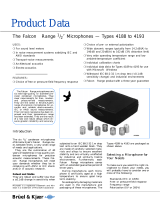Page is loading ...

Headset & Earset Microphones
Manual
dpamicrophones.com/dfine

Omnidirectional characteristics
• The mic is sensitive to sound from all directions
• The sound remains more or less the same regardless of the distance
between the sound source and the mic
• The positioning of mic with omni characteristics is less critical than with
directional
• An omnidirectional microphone is generally not very sensitive to wind,
breathing, pop and handling noises
Directional characteristics
• Rejects background noise and creates higher separation
• The mic is most sensitive to sound on one side (marked on some variants)
• The positioning of mics with directional characteristics is essential as the low
frequency level will change according to the distance to the mouth, known
as proximity eect
• Choose a distance that yields the desired amount of bass
• Care should be taken to protect against wind and pop noise e.g. by using
a windsceen
Introduction
All d:fineTM Headset Microphones provide a uniquely natural and open
sound. Ultra-lightweight and adjustable, these mics ensure a secure and
comfortable fit in live performance environments. To ensure optimal performance
of your d:fine Headset Microphone, please follow the simple instructions below.
Placement of microphone
For discreet placement, you can bend the microphone boom slightly so that the capsule
is placed in the desired position. Do not hold the capsule while bending; bend the wire
boom, making a smooth curve
with your thumb to best fit the
profile of the face.
Mount a directional mic 2-3 cm
(1 in) from the corner of the
mouth to ensure optimal sound
quality compared to an omnidi-
rectional mic that can be placed
further away from the mouth.

How to tell the dierence between d:fineTM Headset Microphone capsules
See the mark on the capsule
See the mark on the capsule
d:fineTM CORE 4166
d:fineTM CORE 4188
d:fineTM CORE 4066,
CORE 4266
d:fineTM CORE 4088,
CORE 4288

Adjusting the d:fineTM 4066 & 4088
The size of the headset mount can easily be adjusted. Change the standard bend by carefully expand-
ing the distance between the earhooks.
To change sides, simply click the boom out of the clips and switch it over to the other side.
The remaining two clips are not used. The soft cable must not be attached into the clips.

Adjusting the d:fineTM 4266 & 4288
For the single-ear, just open the spring hook lightly, first place the slide behind your ear-
lobe (Pic. 1) and let go of the spring over your ear (Pic. 2). For the dual-ear, place the
headset behind your ears and place the springs like for the single-ear. Adjust the headset
mount by pulling or pushing the wires until it fits tightly (Pic. 3).
A directional headset should be mounted 2-3 cm (1 in) from the corner of the mouth to ensure
optimal sound quality.
3. The relief is pre-mounted with dual-ear headsets
and supplied with single-ear earsets.
2. Slide the cable into the relief cut.
Correct placement behind the earlobe
Pic. 1 Pic. 2 Pic. 3
See instruction video at
dpamicrophones.com/dfine
1. When using the dual-ear headset mount,
the supplied cable relief should be applied.

Position the microphone properly by pulling or pushing the boom along the slide.
Switch between left and right ear wearing style simply by rotating the microphone boom. Hold on to the earhook while gently
turning the boom.
For the dual-ear versions, also rotate the two earhooks.
Adjust the microphone boom to follow the shape of your face by gently bending the soft steel on the cable hanger.
Adjust the angle of the cable run, also by gently bending the soft steel (see arrows). Position the cable as shown on the picture for
securing the position of the microphone.
The cable relief on the dual-ear version should be fixed in the clip that also holds the two wires on the mount.
Always leave the protection grid on the d:fineTM 4166 Omnidirectional & 4166 Directional capsules, as it protects the inner grid and
oers protection against wind and breathing noise. The protection grid is replaceable.

Service connector to exchange cables or booms on d:fineTM 4166, 4266, 4188 and 4288 Headsets
These d:fineTM Flex Headset Microphones oer exchange of cables or microphone booms. Simply locate the service
access point, pull back the small locking cap and gently pull the boom away from the cable hanger.
Windscreens
The enclosed windscreens oer additional protection against wind and pop noise. Gently draw the windscreen over
the microphone head. For even better protection, bigger windscreens are available.
Sweat stop
The microphone is equipped with a transparent sweat stop around the microphone boom to prevent sweat running
along the microphone boom to the microphone head.
Accessories (see more at dpamicrophones.com/accessories)
Grids and windscreens, cables, adapters, booms and earhooks.

Cleaning d:fineTM 4066 & 4266 mic grids
Remove the mic grid from the mic element and clean the grid using a soft cloth and demineralized
water only. Make sure the grid is dry before remounting it on the mic element. This is not possible
on the d:fineTM 4088 and 4288 types as the diaphragm is protected inside the mic housing and the
protection grids are not removable. Therefore, for these two mics, no attempt should be made
to clean the grid surface and extreme care should be taken not to clog the grids with makeup e.g.
Clothing clip for d:fineTM 4266 & 4288 Head-
set types
The supplied clothing clip allows you to at-
tach the cable to your clothes, thus relieving the
cable draw to the headset mic. This is essential on
especially the single-ear headset mic.
Color codes & cable steer
d:fineTM 4166 Omnidirectional & 4188 Direc-
tional Microphone types come with a number
of cable steer clips in dierent colors. Mounted
on the cable relief, this clip allows for quick rec-
ognition of a specific headset microphone.
Protection cap
The d:fineTM 4166 Omnidirectional & 4188 Di-
rectional Microphones come with a red plastic
cap which serves to protect the microphone
head when putting on makeup, hairspray and
more. Remove the cap before use.

Cable maintenance
The cable is usually longer than required. Make sure that superfluous cable is wound
up in soft figure-of-eight loops (preferably 6-8 cm (2.5-3 in) diameter) and avoid kinks
in the cable.
Use Ecotech2 Multi Degreaser from Finish Line to remove residue from tape,
glue, or makeup on the cable. Do not bend the cable or rub it harshly, it may stress
the inner cores of the cable and cause them to break over time.
General maintenance
The d:fineTM Headset Microphones are resistant to high levels of humidity. How-
ever, care must be taken to keep the mic away from exposure to water and
cleaning fluids and to keep the mic head dry at all times. Do not use spray or use
fluid containing chemicals that could remove static electricity on or close to the
microphone. This could cause permanent damage.
MicroDot connectors and adapters
To provide users with safe and compact mounting of connec-
tors, all headsets from DPA are fitted with the MicroDot con-
nector as standard. A broad range of connection adapters is
oered as optional accessories for most wireless systems for
professional use. See dpamicrophones.com/adapters.
Please also note that standard hardwired solutions are available
for popular wireless systems;
03 : 3 pin LEMO
10 : TA-4F Switchcraft
34 : Mini-Jack

Frequency Response of d:fineTM 4166 Omnidirectional types
Frequency Response of d:fineTM 4188 Directional types
dB
10
0
-10
-20
-30
20 Hz 50 100 200 500 1 kHz2 5102
04
0
1 kHz 2 kHz 20 kHz 16 kHz
8 kHz
4 kHz
5 dB
dB
10
0
-10
-20
-30
20 Hz 50 100 200 500 1 kHz2 5102
04
0
Black line is near field (2 – 3 cm/0.8 – 1.2 in).
Green line is far field (more than 30 cm/12 in).
250 Hz 500 Hz 8 kHz
16 kHz
4 kHz
2 kHz
1 kHz
5 dB
Polar Pattern of d:fineTM 4166 Omnidirectional types
Polar Pattern d:fineTM 4188 Directional types

Frequency Response (d:fineTM 4066 & 4266 Omni Headset types)
Frequency Response (d:fineTM 4088 & 4088 Directional Headset types)
5
4 kHz
250 Hz
125 Hz
20 kHz
16 kHz
8 kHz 2 kHz
1 kHz
500 Hz
80 Hz
Polar Pattern (d:fineTM 4066 & 4266 Omni Headset types)
Polar Pattern (d:fineTM 4088 & 4088 Omni Headset types)

Directional pattern
Omnidirectional
Principle of operation
Pressure
Frequency range
20 Hz - 20 kHz
Frequency range, ±2 dB
d:fine™ CORE 4166:
20 Hz - 20 kHz with 3 dB soft boost at 8 - 15 kHz
d:fine™ CORE 4066 Act & Flex:
20 Hz - 20 kHz with 3 dB soft boost at 8 - 20 kHz
Sensitivity, nominal, ±3 dB at 1 kHz
6 mV/Pa; -44 dB re. 1 V/Pa
Equivalent noise level, A-weighted
Typ. 26 dB(A) re. 20 µPa (max. 28 dB(A))
S/N ratio (A-weighted),
re. 1 kHz at 1 Pa (94 dB SPL)
Typ. 68 dB(A)
Total harmonic distortion (THD)
<1% up to 137 dB SPL peak
Dynamic range
Typ. 111 dB
Max. SPL, peak before clipping
144 dB
Power supply (for full performance)
Min. 5 V - max. 50 V through DPA adapter for
wireless systems.
Current consumption
Typ. 1.5 mA (microphone)
3.5 mA with DAD6001-BC XLR adapter
Connector
MicroDot
Color (microphone, cable and earhook)
Black, beige, brown
Cable length
1.25 m (4.1 ft)
Cable diameter
1.6 mm (0.06 in)
Temperature range
-40°C to 45°C (-40°F to 113°F)
Relative humidity (RH)
Up to 90%
Directional characteristics
Cardioid
Principle of operation
Pressure gradient
Frequency range
20 Hz - 20 kHz
Frequency range, ±2 dB,
Near field 2-3 cm (0.8-1.2 in)
d:fine™ CORE 4188:
100 Hz- 20 kHz with 3 dB soft boost
100 Hz - 20 kHz with 4-6 dB soft boost at 15 kHz
Sensitivity, nominal, ±3 dB at 1 kHz
6 mV/Pa; -44 dB re. 1 V/Pa
Equivalent noise level, A-weighted
Typ. 28 dB(A) re. 20 µPa (max. 30 dB(A))
S/N ratio (A-weighted),
re. 1 kHz at 1 Pa (94 dB SPL)
Typ. 66 dB(A)
Total harmonic distortion (THD)
<1% up to 137 dB SPL peak
Dynamic range
Typ. 111 dB
Max. SPL, peak before clipping
144 dB
Power supply (for full performance)
Min. 5 V - max. 50 V through DPA adapter for
wireless systems.
Current consumption
Typ. 1.5 mA (microphone)
3.5 mA with DAD6001-BC XLR adapter
Connector
MicroDot
Color (microphone, cable and earhook)
Black, beige, brown
Cable length
1.2 m (3.9 ft)
Cable diameter
1.6 mm (0.06 in)
Temperature range
-40°C to 45°C (-40°F to 113°F)
Relative humidity (RH)
Up to 90%
Specifications
d:fineTM CORE 4066, 4166 & 4266 Omnidirectional Headset Microphone types
Specifications
d:fineTM CORE 4088, 4188 & 4288 Directional Headset Microphone types
DPI-dfine-C-M
© Copyright 2017
Service & repair
If you are not satisfied with the characteristics exhibited by this product, please contact your
nearest DPA Microphones representative for support.
Warranty
d:finetm CORE Headset Microphones are covered by a two-year limited warranty.
CE marking
This product conforms to all relevant directives approved by the European Commission.
Product features and specifications are subject to change without notice.

dpamicrophones.com/dfine
/



